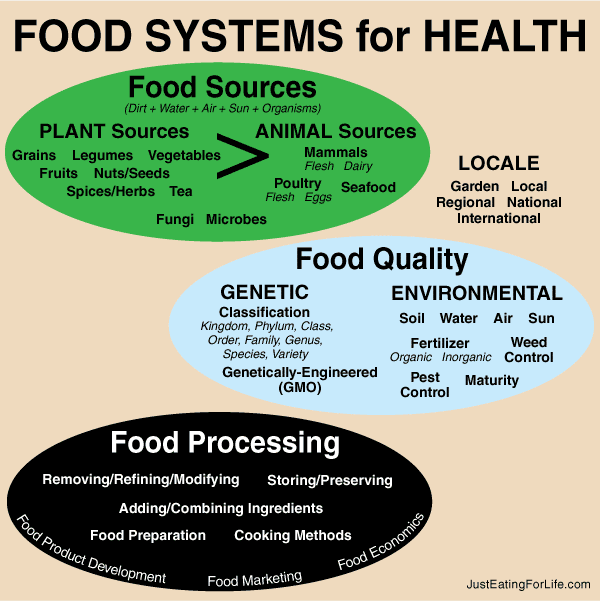Food does not come out of thin air — foodstuffs generally need dirt, water, sunlight, and some kind of seed. Food does not magically appear in supermarkets — food is generally processed, stored and transported. Much of the time, food doesn’t even appear on your plate without substantial further storage, processing and cooking at home or out and about. Food doesn’t become nutrition until your digestive system profoundly processes whatever food goes into your mouth. Food originates within systems both natural and man-made. Human agricultural, food processing, food marketing, and consumer practices deeply shape the nature of our food, the ultimate nutrition it may provide, local economies and the ecology of our planet.

PRINCIPLES OF A HEALTHY, SUSTAINABLE FOOD SYSTEM
The Academy of Nutrition and Dietetics, American Nurses Association, American Planning Association, and American Public Health Association initiated a collaborative process to develop a set of shared food system principles. The following principles are a result of this process and have been collectively endorsed by these organizations:
We support socially, economically, and ecologically sustainable food systems that promote health – the current and future health of individuals, communities, and the natural environment.
A healthy, sustainable food system is:
HEALTH-PROMOTING
• Supports the physical and mental health of all farmers, workers and eaters
• Accounts for the public health impacts across the entire lifecycle of how food is produced, processed, packaged, labeled, distributed, marketed, consumed and disposed
SUSTAINABLE
• Conserves, protects, and regenerates natural resources, landscapes and biodiversity
• Meets our current food and nutrition needs without compromising the ability of the system to meet the needs of future generations
RESILIENT
• Thrives in the face of challenges, such as unpredictable climate, increased pest resistance, and declining, increasingly expensive water and energy supplies
DIVERSE IN
• Size and scale—includes a diverse range of food production, transformation, distribution, marketing, consumption, and disposal practices, occurring at diverse scales, from local and regional, to national and global
• Geography—considers geographic differences in natural resources, climate, customs, and heritage
• Culture—appreciates and supports a diversity of cultures, socio-demographics, and lifestyles
• Choice—provides a variety of health-promoting food choices for all
FAIR
• Supports fair and just communities and conditions for all farmers, workers and eaters
• Provides equitable physical access to affordable food that is health promoting and culturally appropriate
ECONOMICALLY BALANCED
• Provides economic opportunities that are balanced across geographic regions of the country and at different scales of activity, from local to global, for a diverse range of food system stakeholders
• Affords farmers and workers in all sectors of the system a living wage
TRANSPARENT
• Provides opportunities for farmers, workers and eaters to gain the knowledge necessary to understand how food is produced, transformed, distributed, marketed, consumed and disposed
• Empowers farmers, workers and eaters to actively participate in decision-making in all sectors of the system
A healthy, sustainable food system emphasizes, strengthens, and makes visible the interdependent and inseparable relationships between individual sectors (from production to waste disposal) and characteristics (health-promoting, sustainable, resilient, diverse, fair, economically balanced, and transparent)
of the system.
from: http://www.planning.org/nationalcenters/health/foodprinciples.htm
You can download a PDF version of these principles here: https://planning-org-uploaded-media.s3.amazonaws.com/legacy_resources/nationalcenters/health/pdf/HealthySustainableFoodSystemsPrinciples_2012May.pdf
